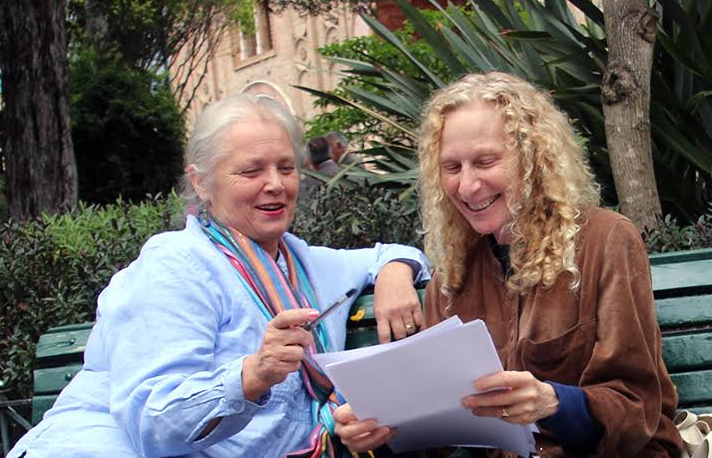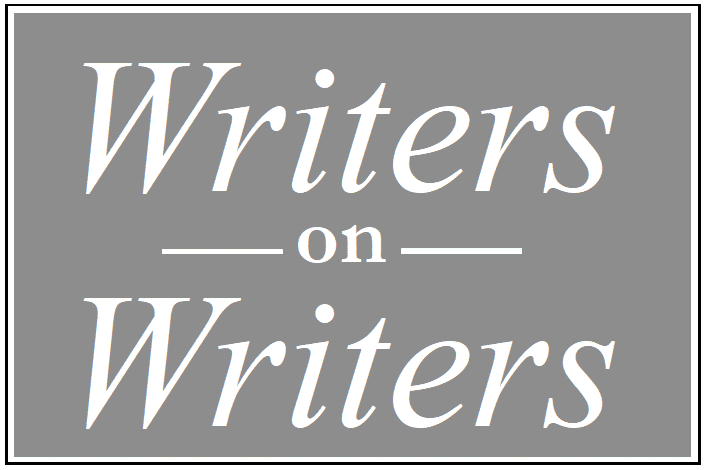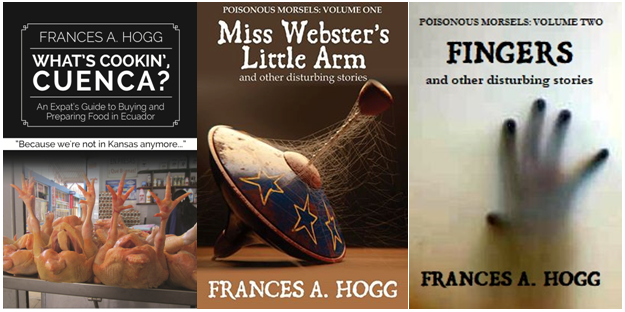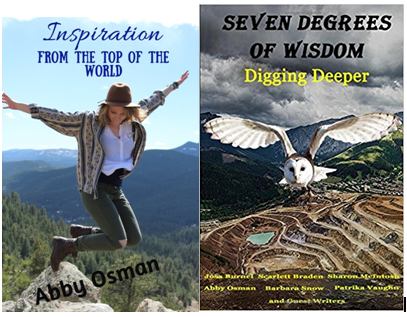Cuenca authors talk about short-story writing

Frances A. Hogg (left) and Abby Osman share a laugh while discussing the craft of short-story writing in Cuenca’s Parque Calderon. (Photo by John Keeble)
Editor’s note: Writers on Writers in an on-going series in which Cuenca expat writers interview each other about their their work.
Writers’ Q&A (Part 1): Abby Osman asks Frances A. Hogg about her writing.
writing.
Franny, most gringos know you as an author because of What’s Cookin’, Cuenca?, a cooking and shopping guide, but now your most recent book is a collection of creepy stories. What drew you to the horror genre?
I’m not exactly sure of the genre of my writing. Some are horror stories, some aren’t. They all have surprising endings. My first novels were mysteries, but then I was hired as a story editor for Dark Moon Digest. I hadn’t been a huge horror-fiction fan before then but reading all those zombie stories made me think, “I can do better than this!”
Conversation continues below graphic.
 How do story ideas come to you?
How do story ideas come to you?
The title story of the first Poisonous Morsels volume, “Miss Webster’s Little Arm,” came from a dream I had about 40 years ago. I dreamed I was in elementary school and one of the “lunch ladies” was pouring gravy over mashed potatoes using a little arm that grew out of the side of her neck. It was such a disturbing image, I never forgot it. I finally realized it was a story that wanted to be written. So my ideas come from images, snippets of conversation, or people I’ve met. I keep a file of story ideas on my computer. When I’m in the mood, I look through the file and choose something to write about.
How do characters form in your mind?
Characters drive my stories. I try to put myself into the heads of people very different from myself—a shy Mexican cemetery guard, a pedophile museum technician, an obsessed photographer, a jealous eight-year-old Cub Scout. I ask myself questions about them. What are they afraid of? What would be the best thing that could ever happen to them? What would be the biggest disaster? The answers help me build a plot with a fun or creepy ending.
Howhas living in Cuenca impacted your writing?
Our supportive community makes getting feedback easier.My critique group is packed. I produce The Spoken Word, a monthly performance by writers of their current work. We usually have a full house. At the book launch for What’s Cookin’, Cuenca?, 220 people showed up. That’s pretty amazing! But also, living as an expat, my world view is expanded. I write and think about people with different backgrounds and experiences from my own. That makes for more interesting stories.
What do you find is most challenging about writing short stories?
Mark Twain once wrote, “I didn’t have time to write a short letter, so I wrote a long one instead.” Shorter is always harder. You must establish all of the elements of a story—character, setting, story arc, resolution—with efficiency. Every word becomes important. It is writing pared down to its core. I suggest to all writers that they practice writing flash fiction daily. Start writing, after ten minutes, stop.
What are you reading now?
I don’t get to read much just for enjoyment. Because I’m an editor, it’s work. But I love reading Cuenca writers—Tom Larsen, Nancy Thornton, Kristen Sawyer, and Su Terry write fabulous short fiction and essays.
What is your writing process?
I let story ideas percolate—sometimes for a few years! I’m always thinking about how I can move a story line or find a believable way to get my characters into the positions I need them to be in to tell their stories effectively. Then some morning I’ll make a pot of coffee, throw the cat out of my favorite chair, and open my laptop. I try to write a new story every week.
What are your next projects?
I’m working with an artist in Detroit on new covers for the reissue of my mystery novelsbased on my life there as an inner-city legal-aid attorney. The second volume in Poisonous Morsels series, called Fingers and other disturbing stories, will be published in May, and in June I’m presenting a creative writing retreat with Cuenca and coastal writers in Olón. I’m also perfecting my website at francesahogg.com.
How can I obtain your books?
My books are available at the Carolina Bookstore and the Carolina Bookshop(in the Vegetable Bar) andthrough my website at FrancesAHogg.com. You can reach me at franny@francesahogg.com.
Q&A (Part 2): Frances A. Hogg asks Abby Osman about her books.
Abby, what brought you to short-story writing?
I started writing poetry as a kid, put it down, then 20 years later started again. Now another 20 years later I ventured into prose, which I enjoy immensely. In looking for my genre, I thought flash fiction fit the bill, being shorter fiction pieces, but when challenged and encouraged, especially in the collaboration of the Seven Degrees of Wisdom: Digging Deeper book with a number of incredible women writers, I ventured into short stories and longer pieces.
How do ideas for stories come to you?
I’m very visual, so often I see the story. For instance, in “123 Fourth Avenue” I envisioned a Hallmark picture frame in the shape of a house with spaces for a number of photos. Behind each window a vignette unfolds for the people who live in one specific apartment building, what you don’t see behind the closed doors as you walk by looking in the windows.
One-liners wake me up at night begging to be put down on paper. Some sit for a while. Others drag me to the computer immediately. I weave personal experiences and my philosophical views into the stories which deal with some of the serious emotional issues in life that can be painful.
How does a character form in your mind?
My characters are formed from personal and work experience, people I’ve met, or have had a visceral reaction to. I visualize my characters portrayed as real life actors and actresses that are on TV or in the movies.
How has living in Cuenca impacted your writing?
Just about three years ago when I arrived in Cuenca I started attending the monthly Writing Our World (WOW) writers’ meetings. I had a folder full of 20-year-old poems that I had carried with me from the US, and a couple of short stories. With the incredible support and mentoring I received within that group, I became a writer, and eventually, an author. I was nurtured, taught, and supported by multiple people within the group to “just write” and to read my writing aloud. I’ve learned so much from the support groups and critique groups in Cuenca. I would like to give back to the reading and the writing community as well with a mentoring program for new or unsupported writers and a more interactive and inclusionary appreciation for the readers and listeners of Cuenca.
What do you find is most challenging about writing short stories?
Getting all the pieces of writing in, plot, character, point of view, etc. all in most succinctly to provide a picture and scene without too much or too little description allowing the reader to identify without confusion or boredom. Editing out what feels like it is really important to me, but maybe not to the story, can be painful for me.
What is your writing process?
When I get an idea, topic or first line, I write it down and usually walk away from it. I take a lot time brainstorming (and walking around.) Most of the time I can see the ending right away. There’s a big space between the opening and closing lines! Instead of outlining, I’m more of a napkin kind of writer. Specific phrases, situations, words, names, get jotted down on a napkin next to my coffee cup. My stories and characters want me to sit with them and listen so I can feel their story, not just write it. I visualize the story as a movie. Sometimes you have to let go of the story and let the characters just take over. Listening to them keeps me awake at night. Lots and lots of editing from the original and perceived final draft. Then more editing and rewriting.
What are you reading now?
I read the many talented authors right here in Cuenca in all genres. There are so many good writers here—Scarlett Braden, Joss Burnel, Paul Anlee, Tom Larsen, John Keeble, J. Michael Herron, Barbara Snow— that I am reading now and so many more still to read. For an excellent sample of 17 women writers in Cuenca read both of the Seven Degrees of Wisdom books.
Conversation continues below graphic.
 What is your next writing project?
What is your next writing project?
I’m working on an anthology of short stories with a novella that I hope to make available at the Cuenca Writers’ Conference at the end of May.
How can I obtain your books?
Both of these books are available on Amazon. The short story anthology will also be available on Amazon soon.
www.amazon.com/Inspiration-Top-World-Abby-Osman-ebook/dp/B075B194KK
www.amazon.com/Seven-Degrees-Wisdom-Digging-Deeper-ebook/dp/B0788DDC4H





















